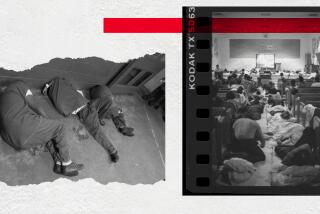They Built It, but Inmates Didn’t Come : Minnesota town’s private prison, built to create jobs, has attracted no ‘clients.’
- Share via
APPLETON, Minn. — Some economically depressed towns on the hunt for new jobs and industry look to medical equipment companies, mail order firms or tourism.
Appleton turned to crime. After studying more than 100 potential industries, this farm town of 1,552 decided to hang its hopes on the nation’s crime wave and overcrowded prison conditions.
Appleton created a nonprofit corporation, raised $28.5 million through a bond sale and built itself a 500-bed medium-security prison. It received its state operating license in November.
But although the Prairie Correctional Facility is ready for business, it doesn’t have any prisoners. And it missed its first principal and interest payments to bondholders, due on Feb. 1.
“I haven’t had a decent night’s sleep in nine months,” said Robert Thompson, city coordinator and the man who conceived the idea of building a prison as an economic development tool.
“Needless to say we’re anxious, hoping desperately something can be done to fill it up,” said Floyd Wojtalewicz, owner of the Apple Cafe. Wojtalewicz, for one, is tired of the negative attention the town is receiving. “The buzzards are circling--that’s my report.”
Meanwhile, the prison’s half-strength staff of 85 continues going to work.
The yellow-walled prison contains cavernous blocks of double and single cells outfitted with plastic mattresses, polyester pillows and clothing hooks that are suicide-proof. Skinny vertical windows provide a view of the outside world: flat, snow-covered fields.
Tim Wassink sat at one of the prison’s metal cafeteria tables, wearing the orange coveralls that identify him as a “prisoner.” Since there aren’t any actual inmates, the staff has to improvise through role playing, simulating inmate daily routines, medical emergencies and even escape attempts.
In his last job, Wassink ran a milk route for 11 years, and never got a vacation. “There was nothing else to do around here,” he said.
The guard job he landed requires a high school education, so Wassink earned his GED certificate, 30 years after quitting school. “As soon as they started building the prison you’d be surprised how many people had hope again.”
A new Super 8 motel was erected on the outskirts of town and a furniture store opened its doors, too. Residents started fixing up their homes.
A feasibility study indicated that once the prison was built, the prisoners would quickly follow. The nation’s prisons are crowded and incarceration rates are soaring, rising from 154 to 274 inmates per 100,000 population between 1981 and 1988. Many states routinely release their prisoners early to relieve overcrowding.
But the recession is hurting Appleton’s efforts to attract inmates.
“What we have found is that policy-makers can’t raise money to house them anywhere,” said Chuck Brown, a state legislator.
California has acute overcrowding problems, but isn’t interested in shipping prisoners to Appleton, despite the prison’s offer to pay transportation costs.
“I don’t envision us going out of state,” said Christine May, spokeswoman for California’s Department of Corrections.
Now that the Appleton prison is in a bind, Brown has introduced legislation designed to get the state of Minnesota to buy or lease the facility or just send its own inmates here.
But relying on Minnesota inmates was never part of the original plan. The state’s own prison population is growing by 200 to 300 inmates a year, but plans call for retrofitting former state hospitals to accommodate them.
And this non-union prison pays wages that start at $12,000 a year for guard trainees, considerably less than what the state’s unionized prison workers earn.
The project’s major bondholder is Minneapolis-based IDS Financial Services Inc., which has told the town it’s willing to be patient.
“The economics of the project are very viable,” said Mike Kennedy, IDS spokesman. “We thought that in the beginning and we think that now.”
Although there are more than 50 correctional facilities managed by private firms in the United States and in Great Britain and Australia, most line up their contracts before breaking ground, said Charles W. Thomas, a University of Florida criminology professor.
Appleton’s is partially modeled after the Great Plains Correctional Facility in Hinton, Okla. “We experienced some of the same problems as Appleton,” said Lester Harmon, the prison’s deputy warden for administration. After being ready to open in June, 1991, the prison waited about four months for its first substantial contract.
The prison eventually was able to gain a contract with the Federal Bureau of Prisons, but Appleton has no assurances it will be as lucky.
So the town continues to wait. “I’m glad we did it; we were dying anyway,” said Dianne Johnson, news editor of the Appleton Press and president of the local Chamber of Commerce. “We had to try something.”
More to Read
Sign up for Essential California
The most important California stories and recommendations in your inbox every morning.
You may occasionally receive promotional content from the Los Angeles Times.










